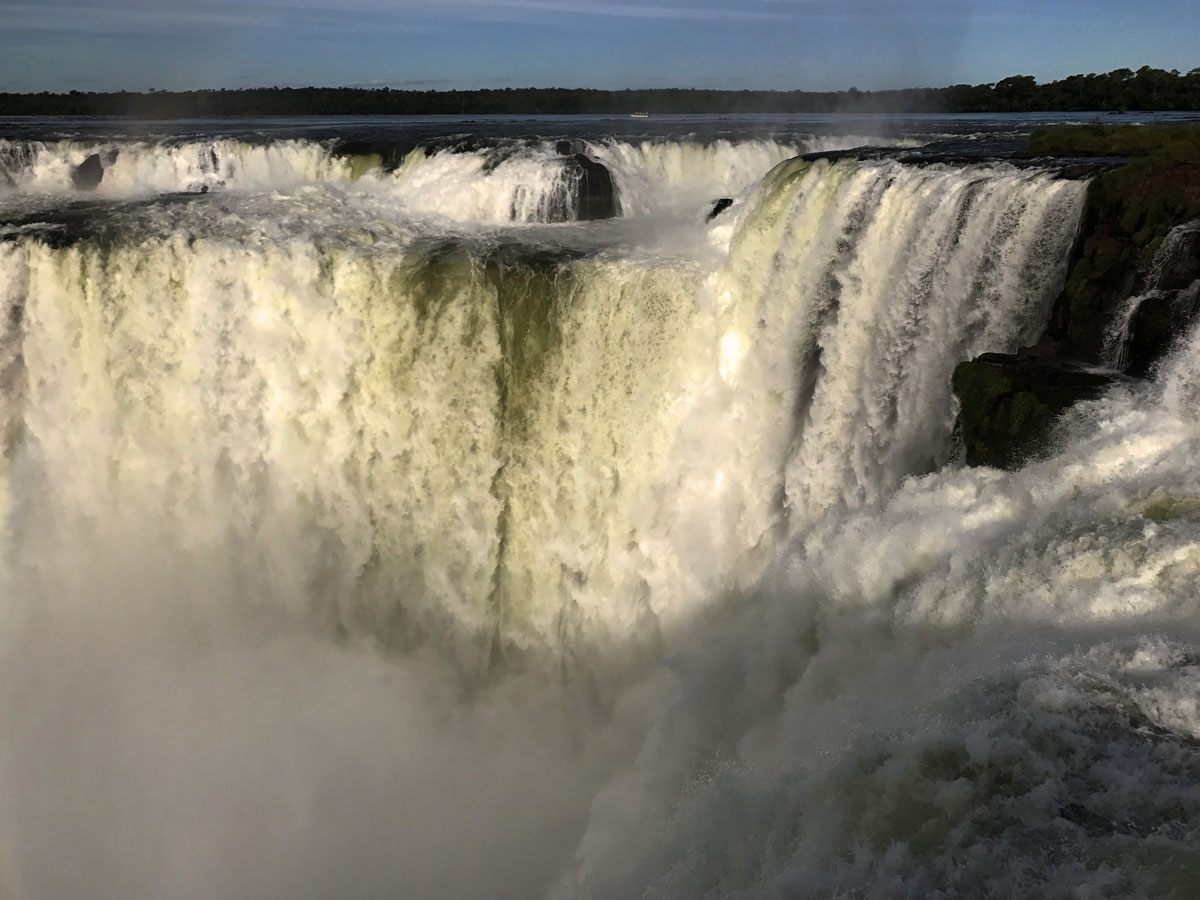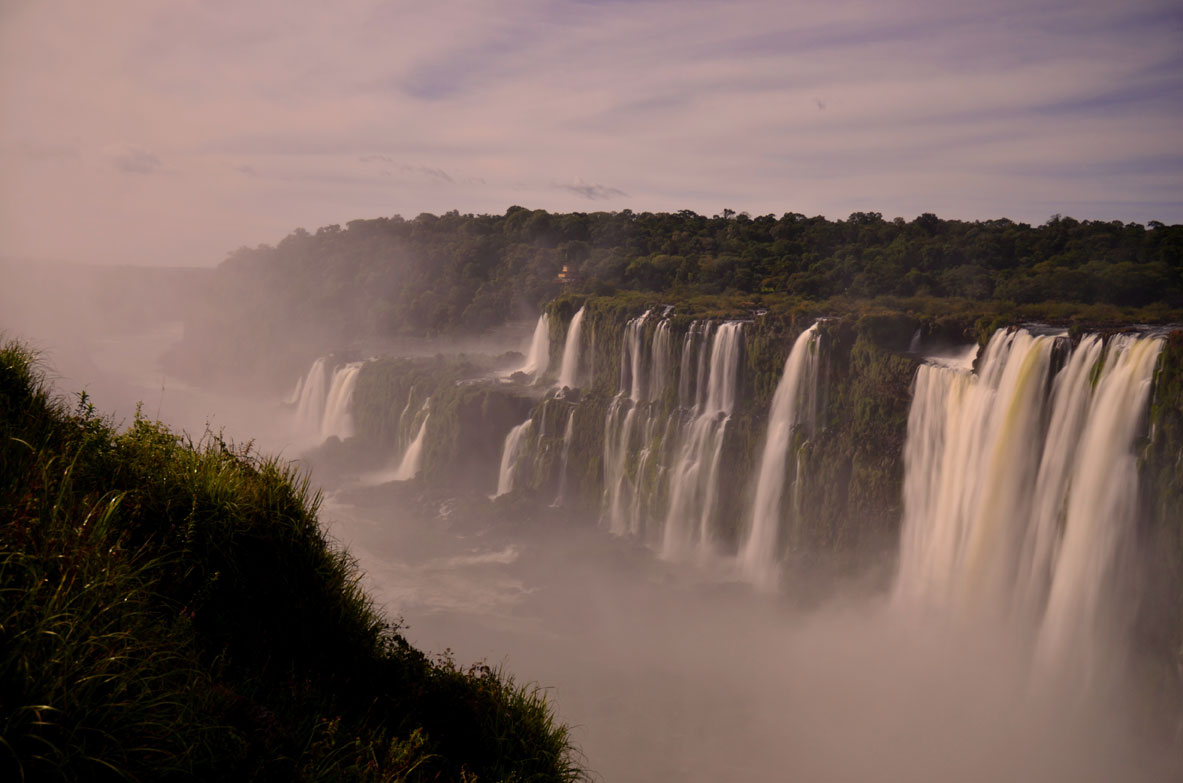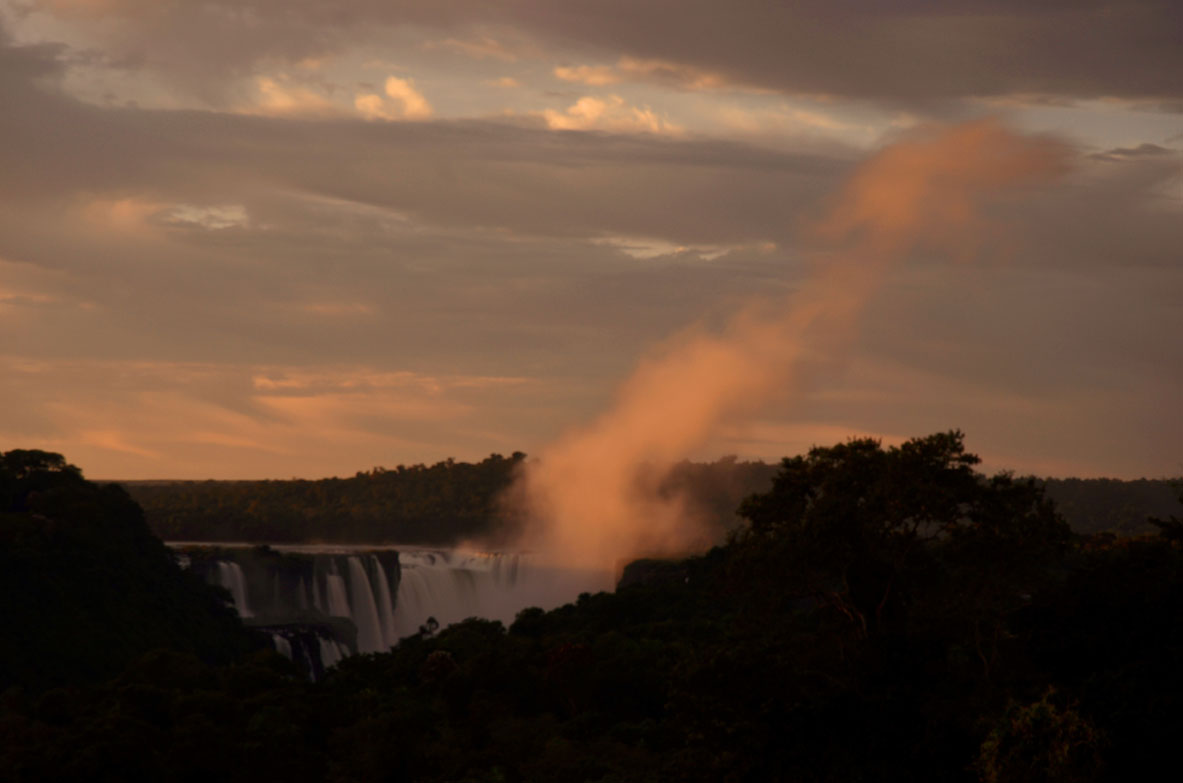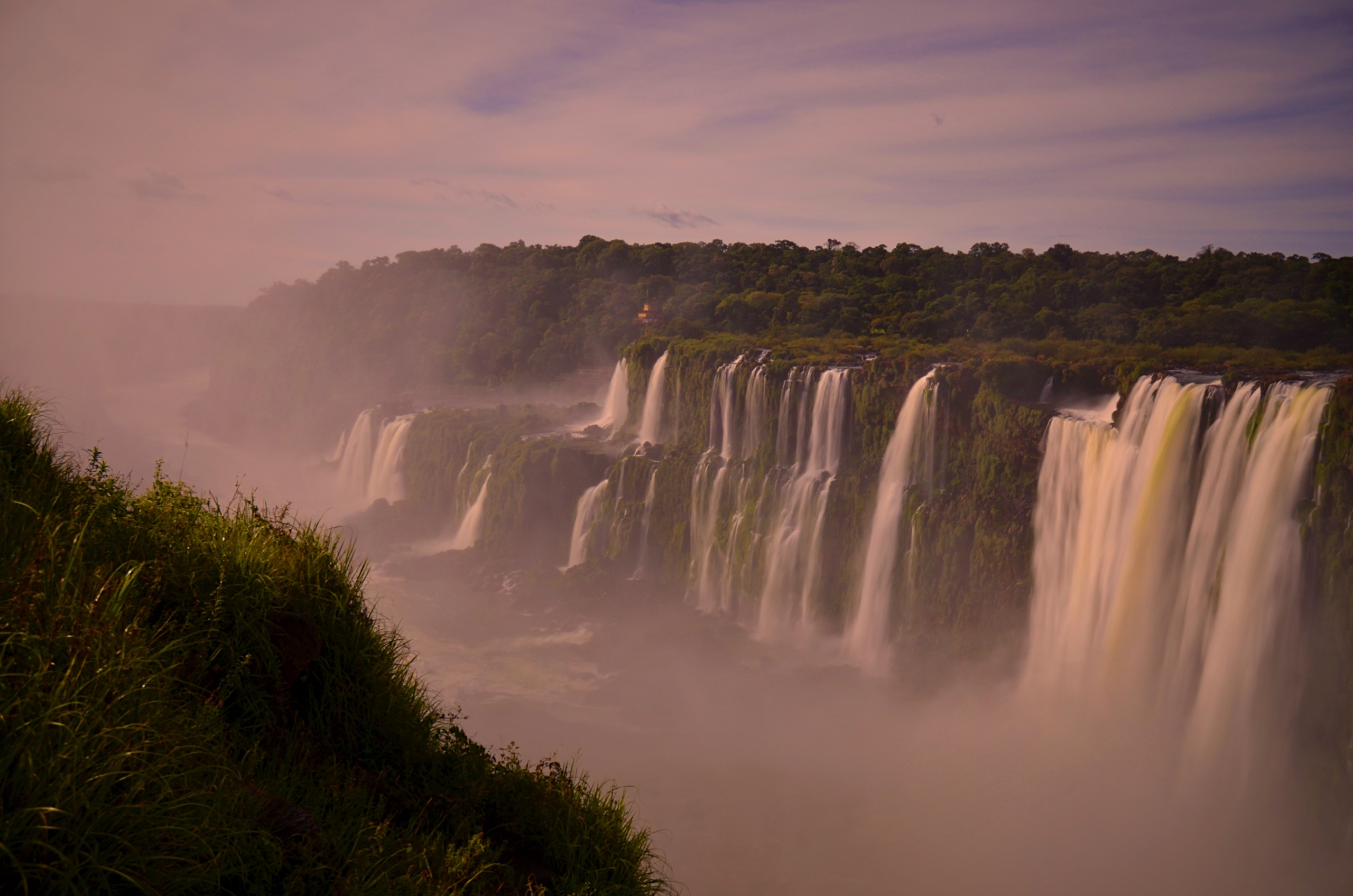ARGENTINA – IGUAZU FALLS
One could make a case that Iguazu Falls is the most impressive waterfall system in the world. It is a series of over 200 falls over a mile and half, some quite powerful, cascading down over 600 feet (twice the height of Niagara). Not slighting New Zealand, it looks out of Lord of Rings. It is on the border of Brazil and Argentina. The Brazil side has the best single view, but Americans must pay a hefty visa fee of $160 to enter the country. On the Argentina side, there is a park with a several scenic outlets. We were there two days, and we did not have enough time and energy to walk every path.
We stayed at the Sheraton Hotel in the park for one night. We arrived about 1:00pm and left 3:30pm the next day. It is convenient, as other hotels are ten to twenty miles away. Being in it, you can maximize your time in the park and rest in your room in the middle of the day. The trails are open from 8am to 6pm. They are not open later, as it is dangerous in the dark because of the wild animals, including jaguars who sometimes appear. The hotel is expensive and we paid an extra $45 for the window view of the falls. For once, the extra money was worth it, as the sunrise view of the falls was an amazing sight for over a half hour.
It is a one-hour, forty-five-minute flight from Buenos Aires. At the airport, I noticed there were eleven flights to Buenos Aires, no doubt to accommodate the many tour groups. The cost of a round trip flight ranges from about $150 to $400. When we arrived at AEP airport in Buenos Aires, I realized I forgot my tripod. I had bought one specifically for Iguazu and had been practicing with it throughout Patagonia. This was a catastrophe, especially since it was Sunday; which reduces the odds of any camera store being open. I thought that maybe I could buy one on Monday morning in Puerto Iguazu, which is about twelve miles from the park, although this would reduce my time there.
A taxi from the airport to the park is about $10. On the way to our hotel, we paid our park admission fee, as required in cash with Argentina pesos of about $20/person. With admission, you receive a map of the trails. The park is easy to navigate and you don’t need a guide.
After we checked into the hotel, we walked ten minutes to Estacion Cataratas and boarded the Jungle Train (free, part of the admission) and went to the Estaccion Garganta. From here it is a three quarter of a mile walk on catwalks to La Garganta del Diablo (Devil’s Throat).

At the end there is a large lookout, always filled with people, but you can insert yourself next to the rails for a view. This is the powerful part of the falls.
There is a lot of spray, which makes it difficult to photograph. This afternoon the spray came sporadically, so it was manageable. I did not have a tripod, so I put my camera on my bag and placed it on the rail. To get a silky look, you need to have a long exposure. I could hold it moderately long (but not like if I had a tripod) and surprisingly got some decent shots.


After staying on the platform for thirty minutes, we walked back and took the train back to the hotel.
We had learned from a taxi driver that there a duty-free complex in Puerto Iguazu on the border of Brazil. We had the hotel reception call them and found they had tripods and were open to 9:00pm. This was a miracle! We took a bus to town, switched to a taxi and arrived there at 8pm. I bought a light tripod which would do the job. Afterwards, we ate at a parrilla called El Quincho del Tio Querido, Av Pres. Juan Domingo Perón 159. It was a large and lively place; definitely worth checking out.
The next day, I set up the tripod on the hotel room’s balcony. For a half hour, I photographed the sunrise. It was a special experience to see the drama in the sky unfold.

After a quick buffet breakfast, we took the Jungle Train back to La Garganta del Diablo. At the station, there were many coatis (animal resembling the mix between a possum and raccoon) scampering around.

I set up my tripod and camera where I wanted, however, the spray was so heavy and constant that I only could get a few shots in without water drops on the lens, but it was well worth the effort.

We then walked back to the Jungle Train and took it to Estacion Cataratas. We took the Interior Circuit Trail which offers some of the best views of the waterfalls.


There are also two small, unconnected falls: Alvar Nunez and Lanusse.

The path is almost a mile with a sharp descent entering and a steep assent when leaving. By the time we were finished, it was just after noon. As we had to catch at taxi at 3:30pm, needed to shower and pack and wanted some rest and food, so we decided to call it a day with hiking and photographing. The time we spent would be enough for most people. For those who like to see everything or hike or live-to-photograph, an extra day would be a good decision. There are many trails to hike, all with terrific views and the weather changes frequently which affects photography. There are also boat rides which briefly take you to the bottom of the falls for a drenching. The experience looked fun.
The following technical tips are for serious photographers coming to Iguazu Falls:
- To slow down the water motion, you must use a long exposure. To get a silky effect, you need at least a half second exposure, but a minute is good. You can hand hold and get a sharp shot for perhaps 1/15 of a second if have very steady hands and hold your breath. Placing it on your camera bag, may get you up to 1/2 second exposure if you are lucky.
- To reliably do 1/2 second exposures or longer, you need a tripod. A large part of the trails are on catwalks and bridges which vibrate with the many people walking on them. Therefore, the heavier the tripod, the better, but it needs to be easy and quick to set up.
- Usually you can insert yourself between people but cannot linger long, so a tripod head that is easy to maneuver (such as a ball head) is recommended.
- To have longer exposures, you need to add on neutral density filters (anywhere from three-exposure to nine-exposure stops-reduction). The ones with the most exposure stop-reductions let you take the longest exposure, but are very dark to see through. Make sure you are not getting vignetting from the neutral density filter (darkness in the corners of the photo), which can happen if you stack filters. If you do, you then must remove one the filters.
- Camera meters are not accurate for long exposures, because of something call reciprocity failure. Thus, it is important to take multiple shots for different time exposures.
- Usually your focus is set near or at infinity for waterfalls. If you want to photograph someone in front of the fall, be sure focus on their eyes and not the background. Also use a small aperture (say F16 or smaller) to make sure they are sharply focused and as much of the background as possible (maximize the depth-of-field). However, the exposure time can be no less than 1/60 or 1/30 of a second because a person cannot stay still any longer.
- F8 and F11 apertures usually provide the sharpest picture, but you may need to go smaller to have a long enough exposure to slow down the water.
- If you want to make a blue sky darker, use a polarizer filter.
- In many situations, you want to use a wide-angle lens to capture a chunk of the falls. Also use a long lens (probably a zoom), which can give interesting framing.
- A lens hood it very helpful keeping out glare. I found that that snap on or bayonet (mounts onto the end of a lens with a twist) ones work the best, as they less likely to cause vignetting. However, they also can easily come off. A lens hood can be petal shaped or round. The petal shape is less likely to vignette, but it depends on certain factors. Bottom line is probably buy the hood recommended for the lens and test it to see how it performs under different conditions
- The spray can be a problem at La Garganta del Diablo. An umbrella may help, but it is one more thing to carry.
- Take many shots at different focal lengths and exposures. Even though you can see the image on the back of the camera, it is difficult to determine details until you come back home and look at them on your computer.
- Practice as much as possible with your equipment before you come to a place like Iguazu Falls, so you maximize your chances of good shots.
- Give yourself as many days as you can afford at the falls, especially as the weather and sky conditions change often.
- Keep a list of essential accessories, so you do not forget something (like I did with my tripod).
- Read accounts of others photographing at Iguazu for their recommendations. See https://www.pinterest.com/exploringed/boards/ for articles on photographing Iguazu (in the Argentina Travels Info board) or waterfalls (in the Photography board).
- When you return home, the photographs will never live up to your memory of the place. Be happy with whatever you end up with.


